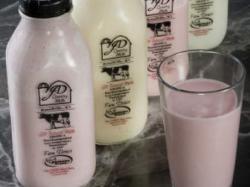In Search Of Good Food, Old-Style Dairy Sells New Yogurt
August 5, 2010 | 1 min to read

What will they think of next? First, they decided to sell old-fashioned whole milk. Instead of using brute force homogenization, a process that breaks down the structure of milk and robs it of its natural flavor and mouth-feel, they decided not to homogenize at all. The result: a milk that settles into layers, with the voluptuous cream rising to the top, creating what's called a “cream line.”
They decided not to use fast, modern “ultra-pasteurization” techniques. Instead, they opted for slow, low-temperature pasteurization. “Ultra-pasteurization” is one of those things that make sense for a manufacturer, because it produces milk with a shelf life of months instead of days, making it easier for producers and retailers to hold it in warehouses for long periods of time.
But despite the “ultra” label, which seems to suggest it's somehow better than plain old regular pasteurization, it's no safer. And from an aesthetic standpoint it results in milk with a dull, cooked taste that's downright unpleasant.
To read the rest of this story please go to: The Courier Journal
